By: debbie lynn elias
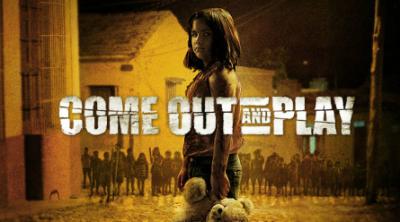
Makinov is a master of manipulation. Pushing the envelope and imbuing his personal manifesto of life within both his filmmaking process and his cinematic product, the mystery that surrounds the red-hooded man appears on screen with COME OUT AND PLAY. As if daring the audience to join the “games”, Makinov teases, taunts and titillates with terror, bringing us to the edge of emotional orgasm of fear, only to pull the rug out from under this masterful web of intrigue, leaving the audience filled with unanswered questions and a feeling of “What the hell was that?”
Francis and Beth are off for a last vacation before the birth of their latest child. Ready to deliver at any moment, one wonders what Beth is even doing in a remote tropical setting so far from a hospital, doctor and modern medicines. But Makinov immediately starts to reel us in with the beauty of the region and with starts out as a seemingly idyllic tropical getaway. Sun, sand, blue waters. Gorgeous, soft and soothing panoramic vista. But look a little closer at Francis and you get a feeling of uncertainty and sketchiness…and that he’s a know-it-all who knows nothing. He’s out in the night? Not that well versed in the language and making deals for boats and whatnot?
What’s Francis up to?
While that imagery stews in your brain, we meet Beth. Very very pregnant and not a happy camper at the heat and her own nausea, but Francis seems intent on dragging her to wherever. Wherever turns out to be an island; an island apparently WAY off the beaten path but known for some incredible annual festival. Yet when Francis and Beth arrive that morning, there is no festival. The streets have rolled up and there’s not a soul in sight.
What’s going on? Where is everybody? And if there was a festival, why aren’t the streets strewn with empty beer bottles?
A very tired, very hungry and very thirsty Beth (why they didn’t think to pack any water or snacks in the multiple duffle bags they brought with them is beyond me – yet, she remembers her camera) sets them out on a search for a restaurant, grocery store, whatever. But as they walk through town, there isn’t a sound, a peep.
Where is everyone? What’s going on?
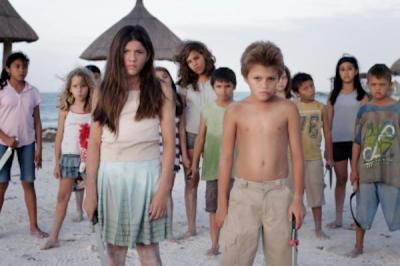
We see a child, a young pre-teen girl who wanders into a restaurant where Beth is resting, awaiting Francis’ return from his search for a grocery store since there are no restaurant owners to be found. There is however, burning toast in a toaster that was left on as if someone left in a hurry. How long was it burning? A quick search reveals no food or no edible food in the place.
And we wonder. What’s going on?
The girl warily approaches Beth. Never speaking, never responding or reacting to questions from Beth, she touches the pregnant belly and lays her head on it, then leaves without a sound.
Why?
In the meantime, Francis sees a boy in the street. Calling out to him, the young child doesn’t answer, but takes off running. Francis follows. The kid disappears.
Where did he go?
Realizing something is amiss, Francis continues his foraging for food and drink and returns to Beth who is now exhausted and wants to lie d own. Walking further in town they come across an elderly man who is beaten to a pulp by a kid. Unable to help, fear sets in.
Now we’re really wondering – WTF? Why is the kid beating the old man? Where is everyone?
Taking refuge in a hotel, again, there is no one there. But there are frantic panicked calls coming over the CB or shortwave radio, in a language neither Beth nor Francis can understand. A search of the hotel turns up dead bodies and eventually a frightened manager who explains the children are killing people.
Why?
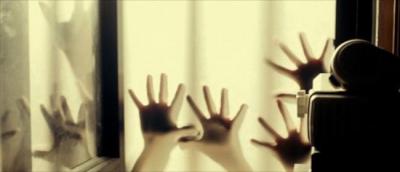
Back out on the street looking for help or a way off the island, Francis sees a playground full of kids, all beating and attacking the old man he tried to save earlier. Giggling, laughing and playing, they sound normal, but they don’t speak and appear to communicate with each other telepathically.
Huh? Double WTF?
Knowing they must leave this island, Francis and Beth make a daring attempt at escape from the town all the while hunted like animals by packs of children, wolves moving in for the kill. Escaping them, they find a seaside village where an older woman gives them food and water and rest. Her grandchildren play in the surf quietly lapping the shore. They appear to be normal children. But the pack finds Beth and Francis. As they flee, the pack descends on the shack and the normal children in the surf. We can only guess at what is happening.
Eventually locking themselves in a local jail, Beth and Francis know that they are now the caged animals about to be fed to the wolves. Their only hope is that emergency radio calls made earlier would be heard by someone and help would arrive. But what kind of help and would it arrive in time?
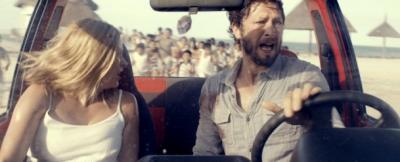
What has happened to this town? To the children? Why do they not speak? Why do they kill? Why do they play with body parts as jewelry and boomerangs? What is wrong with them? How did this happen? What was the catalyst? Can I send my siblings to this island? Questions, questions, questions and more questions but never any answers makes for frustrated viewing. This is quite possibly an obvious side effect of Makinov wearing a red hood and scarf covering his head and face – he clearly can’t see the words on a script to know when he needs a fulfilling ending or he can’t see what’s happening when shooting. Perhaps he wears the red hood to invoke and evoke fear in the actors’ performances, scaring them into getting in front of the camera, hypnotically suggesting he himself is the devil. There are as many questions about Makinov’s mindset and filmmaking process as in COME OUT AND PLAY itself.
Color in the film is very minimal but for RED which is always pungent and bright. It’s a wonderful contrast to the sickly green in the jail, the serenity of the pale tropical waters and beaches, the plastered buildings, bamboo shacks and thatching. Essentially a one man crew consisting of himself, himself, himself, himself, himself and himself, the lack of input and collaboration shows in the uneven editing and use of wide shot often go too wide, completely removing the audience from the already questionable antics on screen. Where Makinov does technically excel is with his scoring, which he also composed. It plays on the senses and fuels tension and suspense.
Ebon Moss-Bachrach doesn’t sit well with me in his performance of Francis. He comes across as untrustworthy, wimpy and not the brightest bulb in the box which then casts aspersions onto the character of Beth. Vinessa Shaw does an “okay” job with Beth. Although uneven and rather one note in her emotional palette, you do get invested in her character…and her camera which was left on the table in the hotel patio….. Does this mean there’s a sequel?
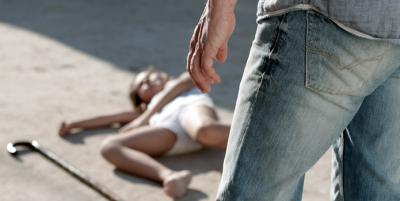
I will say, his cast of miscreant children are exemplary and I do like their ingenuity at creating ear and finger necklaces and other uses of body parts. Nice machete, saw and hammer handling, too.
As I said, Makinov masters manipulation as you cannot look away from this film. He creates a craving within, tapping into the human nature of curiosity, begging you to COME OUT AND PLAY. But sadly, he never tells you why, leaving you frustrated and yearning for answers.
Written and Directed by Makinov
Cast: Ebon Moss-Bachrach, Vinessa Shaw












